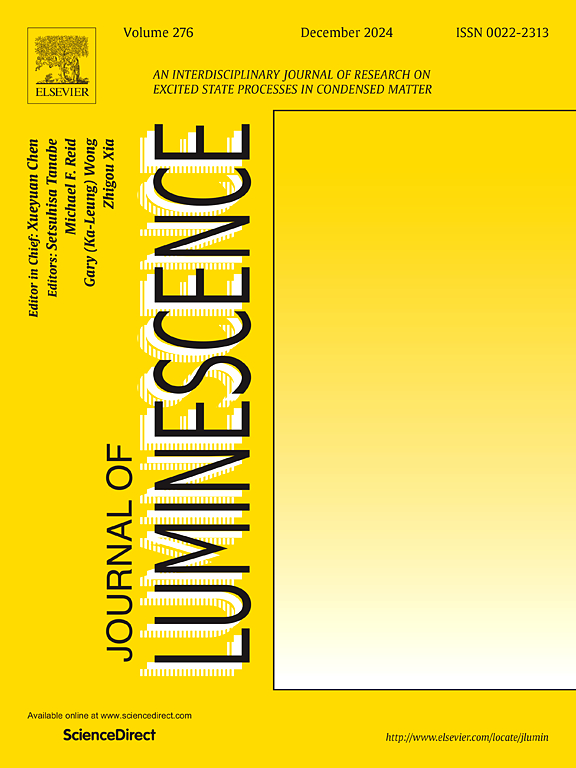ESIPT molecular probe FET: Electric field effect on spectral properties
IF 3.3
3区 物理与天体物理
Q2 OPTICS
引用次数: 0
Abstract
Employed DFT calculations to investigate the electric field effect on the structure, spectral properties, excited-state intramolecular proton transfer (ESIPT) reaction, and dipole moments of 4′-(Diethylamino)-3-hydroxyflavone (FET). FET, a well-known fluorescent 3-hydroxyflavone, exhibits efficient dual fluorescence from its normal and tautomeric forms. Our simulations revealed a significant field effect on the singlet state energies, electronic transition frequencies, and molecular orbital surfaces. FET molecules demonstrate significant polarizability, leading to a ∼50 % increase in the permanent dipole moment in the singlet states.
The changes in electronic transition frequencies induced by the applied electric field provide a basis for understanding the modulation of spectral characteristics in solvents where the solute interacts with the electric field of the reaction cavity. Furthermore, incorporating intermolecular interactions using the Onsager model allows us to elucidate how solvatochromism and significant inhomogeneous spectral broadening of vibronic spectra may arise in polar solvents due to thermal fluctuations of the electric field.
Selective fluorescence spectroscopy of FET in acetonitrile reveals a moderate red shift in the normal form's spectrum and a dependence of its intensity on the excitation energy, a phenomenon known as the red-edge excitation effect (REEE), at room temperature. Traditionally, REEE is observed when solutes are in immobilized environments, such as frozen matrices, polymers, or membranes. We attribute the observed REEE pattern to interplay of spectral solutes inhomogemeouty and the unique characteristics of the fast ESIPT reaction.

ESIPT分子探针场效应管:电场对光谱特性的影响
利用DFT计算研究了电场对4 ' -(二乙胺)-3-羟基黄酮(FET)的结构、光谱性质、激发态质子转移(ESIPT)反应和偶极矩的影响。FET是一种众所周知的荧光3-羟基黄酮,从其正常和互变异构形式表现出有效的双荧光。我们的模拟揭示了场对单线态能量、电子跃迁频率和分子轨道表面的显著影响。FET分子表现出显著的极化性,导致单线态的永久偶极矩增加~ 50%。外加电场引起的电子跃迁频率的变化为理解溶质与反应腔电场相互作用时溶剂中光谱特性的调制提供了基础。此外,利用Onsager模型结合分子间相互作用,使我们能够阐明由于电场的热波动,极性溶剂中可能出现溶剂致变色和显著的不均匀谱展宽。对乙腈中FET的选择性荧光光谱分析表明,在室温下,正常形式的光谱中存在适度的红移,并且其强度依赖于激发能,这种现象称为红边激发效应(REEE)。传统上,当溶质处于固定环境时,如冷冻基质、聚合物或膜,可以观察到REEE。我们将观察到的REEE模式归因于光谱溶质不均匀性和快速ESIPT反应的独特特性的相互作用。
本文章由计算机程序翻译,如有差异,请以英文原文为准。
求助全文
约1分钟内获得全文
求助全文
来源期刊

Journal of Luminescence
物理-光学
CiteScore
6.70
自引率
13.90%
发文量
850
审稿时长
3.8 months
期刊介绍:
The purpose of the Journal of Luminescence is to provide a means of communication between scientists in different disciplines who share a common interest in the electronic excited states of molecular, ionic and covalent systems, whether crystalline, amorphous, or liquid.
We invite original papers and reviews on such subjects as: exciton and polariton dynamics, dynamics of localized excited states, energy and charge transport in ordered and disordered systems, radiative and non-radiative recombination, relaxation processes, vibronic interactions in electronic excited states, photochemistry in condensed systems, excited state resonance, double resonance, spin dynamics, selective excitation spectroscopy, hole burning, coherent processes in excited states, (e.g. coherent optical transients, photon echoes, transient gratings), multiphoton processes, optical bistability, photochromism, and new techniques for the study of excited states. This list is not intended to be exhaustive. Papers in the traditional areas of optical spectroscopy (absorption, MCD, luminescence, Raman scattering) are welcome. Papers on applications (phosphors, scintillators, electro- and cathodo-luminescence, radiography, bioimaging, solar energy, energy conversion, etc.) are also welcome if they present results of scientific, rather than only technological interest. However, papers containing purely theoretical results, not related to phenomena in the excited states, as well as papers using luminescence spectroscopy to perform routine analytical chemistry or biochemistry procedures, are outside the scope of the journal. Some exceptions will be possible at the discretion of the editors.
 求助内容:
求助内容: 应助结果提醒方式:
应助结果提醒方式:


